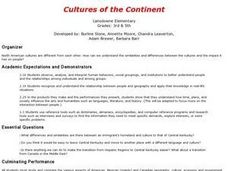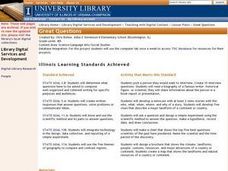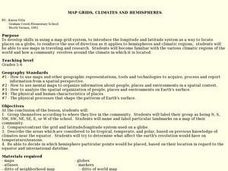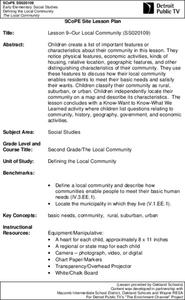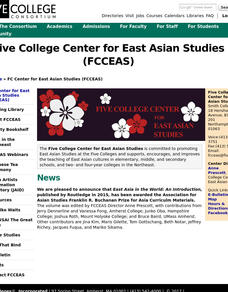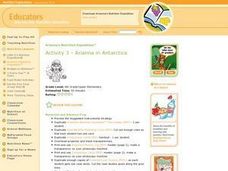Curated OER
Lesson Design Archaeology- U.S. Map
Students examine the U.S. map and identify cultural areas. In this archaeology lesson, students locate cultural areas on the U.S. map and fill in the proper locations.
Curated OER
Cultures of the Continent
Students explore the various cultures of North America. They examine the differences and similarities between an immigrant's homeland and the culture of Central Kentucky. Students discuss strategies to make the transition easier for...
Curated OER
China
Second graders complete a variety of activities surrounding a unit on China and Chinese culture.
Curated OER
Organization of a Territory, Map Elements
Third graders compare printed and online maps and use proper geographic terminology to answer questions.
Curated OER
Great Questions
Fourth graders research and create questions about a famous person. They create questions in a game format, create a computer generated brochure, and develop rubrics for their finished projects.
Curated OER
In Perfect Harmony: Teaching the World to Sing
First graders listen to music as the impetus to learn about the concept of Japanese harmony as it is understood in Japanese culture. They use the New Seeker's song, "I'd Like to Teach the World to Sing," to compare America and Japan...
Curated OER
Origami Paper Fun
Students explore the art of Origami. They listen to various stories about Japan, create Origami shapes by following step-by-step directions, sing Japanese songs, locate Japan on a map, and take a quiz.
Curated OER
Read a Transportation Story
Third graders research the building of a transcontinental road. In this railroad history lesson, 3rd graders discuss past and present transportation. Students look at historical photos and compare and contrast photos from today.
Curated OER
Comparing Three Religions: Islam, Judaism, and Christianity
Students work together in groups to research either Judaism, Christianity, or Islam. Once the research is complete, they share their information with the other groups in the class. They complete a worksheet on rituals and holidays in...
Curated OER
Ancient Egypt: Unearthing the Past
Sixth graders imagine traveling the River Nile, excavating sacred burial tombs, investigating ancient rituals, exploring Wonders of the World, and translating ancient writings.
Curated OER
Introduction to Korean Language and Writing
Young scholars explore the written Korean language and its history. They demonstrate the formation of the Korean characters and pronounce them. As they research the historical information of Hangul, they compare it to the high literacy...
Curated OER
Jambo Means Hello: An Introduction To Swahili
Students gain an appreciation for Swahili as a language spoken in many parts of Africa. They share and illustrate words from their own culture using English and Swahili and others to create a word quilt.
Curated OER
MAP GRIDS, CLIMATES AND HEMISPHERES
Students compare/contrast the grid and latitude/longitude system used on a globe. They describe the areas which are considered to be a tropical, temperate, and polar, based on knowledge of climates.
Curated OER
HUMAN/ENVIRONMENT INTERACTIONS: CLIMATE
Students explore the various global climates and apply cultural adaptations of the peoples in various zones due to climate.
Curated OER
Age of Exploration: A Class Timeline
Fourth graders create Explorer Trading Cards and individual timelines were then created on index cards with the class timeline assembled by putting all of the index cards together. They identify explorers, where they were exploring, and...
Curated OER
Conditions in And Connections To Indonesia
Eleventh graders research an animal and its habitat, the conditions of that habitat and how its connections to the rest of the world are affecting that habitat.
Curated OER
Papier Mache Globe
Students use newspapers and balloons to create a paper mache globe. They define areas of land and sea with geen and blue tempera paint, then define borders with markers.
Curated OER
Making a Region Map of a State
Fourth graders create salt maps of a state and indicate its regions. They include topographical elements including mountains, valleys, lowlands and major water bodies and a compass rose.
Curated OER
Where Do Animals Come From?
Students use library search engines to research an animal and its origin. In this animal research lesson, students research their assigned animal using ProQuest. Students then find the country of origin of the animal using a library...
Curated OER
Human Features of Our Community
Students investigate the human factors that create a community. They conduct research using a variety of sources. Students then create dioramas that depict a typical scene found in a community.
Curated OER
Lesson 9-Our Local Community
Second graders brainstorm and create a list of important features/characteristics that they would want to include in a community setting. They include physical features, economic activities, kinds of housing, etc. This lesson is a...
Curated OER
Haiku
Students study various forms of poetry and the culture of Japan. They are introduced to a haiku- a traditional form of poetry and an art form in the Japanese culture. They write a haiku and create a student haiku booklet with the classes...
Curated OER
Arianna in Antarctica
Fourth graders review their knowledge of the food groups and their benefits. They make comparison flash cards with different foods and their benefits, sharing them in creative ways. Finally, they work in groups to solved case studies...
Curated OER
Hole Hole Bushi
Fourth graders play a written rhythm pattern. They state when a rhythm pattern varies from a given pattern by listening to an ostinato. They state reasons why people migrate to different lands.



